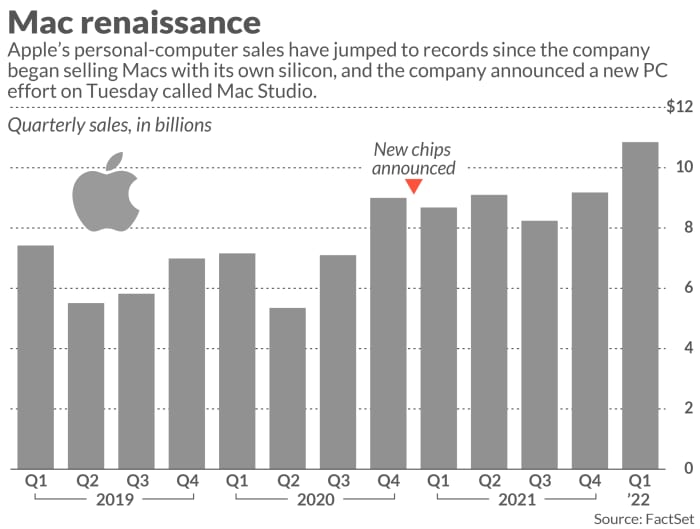The renaissance that Apple Inc. has been experiencing with the Mac — thanks in part to its specially designed chips — is set to receive a big boost with new, higher-end machines.
As part of a broader product launch Tuesday, Apple AAPL, -1.17% unveiled the new Mac Studio, aimed at professional designers, photographers, developers and others who need a high-performance computer. Apple executives also detailed the newest silicon the company developed, the M1 Ultra, and said that the Mac Studio with that chip will cost a minimum of $ 3,999.
Only one Mac costs more than that: the Mac Pro, which was introduced before Apple launched its own chips, at a starting price of $ 5,999, and is the last of Apple’s main Mac offerings designed around an Intel Corp. INTC, -0.38% processor. During the event, Apple executive Johny Srouji said that a Mac Pro upgrade “will wait for another day,” suggesting we will see that machine get Apple silicon later this year, potentially at the next known Apple event, June’s Worldwide Developers Conference, or WWDC.
Full news wrap-up: Apple unveils new Mac Studio with an M1 Ultra chip, along with refreshed iPhone SE and iPad Air
The new high-end machines will join a Mac renaissance not seen since Steve Jobs returned to Cupertino and launched the iMac in 1998, a major rebirth of the then-moribund Macintosh, while also influencing the rest of the PC industry. Since it launched its own custom-designed semiconductors in late 2020, Apple’s line of personal computers has seen strong double-digit growth, with a boom in PC sales during the pandemic adding fuel to the fire.
“Apple silicon has transformed the Mac throughout the past year,” Apple Chief Executive Tim Cook said during the virtual product unveiling from its Cupertino headquarters. “It has ushered in a new era for the Mac.”
In calendar 2021, the company saw record unit shipments and revenue for the Mac (Apple’s fiscal year ended Sep. 30, 2021). In Apple’s last fiscal year, Macs surpassed $ 30 billion for the first time, rising all the way to $ 35.2 billion in annual sales, up 23% from fiscal 2020. In the holiday season, Apple’s fiscal first quarter, Mac sales topped $ 10 billion in three months for the first time ever, and almost reached $ 11 billion.

MarketWatch graphic
While much of this could be attributed to the overall boom in PC sales during the pandemic, Apple’s growth rate has exceeded what its major rivals have experienced. In calendar 2021, according to preliminary calculations by third-party analysis firm IDC, Apple’s unit shipments grew 22%, outpacing the industry growth of 14.8%. Its global market share in PCs grew to 8%, up from 7.5% in calendar 2020, per IDC.
“When they came out with the M1 chip, everything changed. Both consumers and businesses were very excited,” said Maribel Lopez, principal analyst at Lopez Research. “It’s opened up a floodgate of Apple purchases, they had really great numbers for a couple of quarters. It was just amazing, in a market where everyone counted them out.”
See also: The pandemic PC boom gave personal computers their biggest year in nearly a decade
Apple is building on that strength with Tuesday’s product launches, which included the Mac Studio, described as having “groundbreaking performance.” In addition, the company introduced a new high-end monitor called the Studio Display for this system or for other Macs to plug into, which seemed built for high-end videoconferencing, a need that the COVID-19 pandemic exposed.
Apple first launched the M1 — a chip it designed in-house, based on an Arm Holdings Ltd. core — in a fortuitous move at the end of 2020, just as the global supply chain was beginning to be constrained and semiconductors were suddenly in short supply. Apple has touted its chips’ power efficiency and its neural machine to accelerate machine learning, speeding up tasks like video, voice recognition and image processing.
Even with Apple’s supply-chain strength, it has still seen its revenue impacted by constraints of some products. In the September quarter, Cook said that Apple’s revenue was impacted by about $ 6 billion due to supply constraints, and that the December quarter was expected to be hit even harder.
For more: The tiny, $ 1 chip that is behind record price increases for computers
Mikako Kitagawa, an analyst at Gartner, said that processors, also known as CPUs (central processing units), were not an issue in the past year. The shortage for Apple and other PC makers has been of odd, inexpensive, but important parts. “CPUs are really OK, but the shortage was other components like LCD panels, Wi-Fi controllers, really cheap ones,” she said. There has been and still is a lot of competition for LCD panel components, which are in many devices, from monitors, to TVs to cars.
While the M1 has played a huge role in the growth of the Mac in the past year, a few other factors have also been at play.
“Honestly, they have great products,” said Ryan Reith, an IDC analyst. “It basically boils down to their supply chain, and it’s been well-known that whatever the product line, Apple is very tight with their supply chain. When you hit the times we are in now, people with tighter supply-chain agreements tend to win.”
All of that adds up to an unexpected resurgence in Apple’s Mac sales, and a lot more revenue could be on the way if consumers shell out for the high prices commanded for the top-of-the-line Macs. With Apple’s design acumen continuing to impress and Cook’s talent at massaging the supply chain, expect Apple to continue winning in PCs, and racking up billions in revenue as a result.

